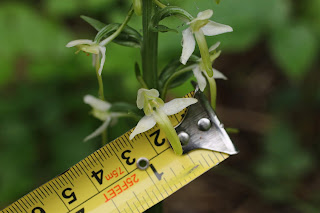I wrote a blog some months ago about a visit to Strawberry Bank in Gloucestershire to look at the butterfly orchids there - a site for both greater butterfly (Pc = Platanthera chlorantha), lesser butterfly (Pb = P. bifolia) and the hybrid between them (Ph = P. x hybrida). In fact in late May and early June I went to 5 sites in all to the north and east of Stroud, finding evidence of hybridisation. I have now had a chance to analyse the data I collected, and review some recent relevant literature.
 |
| Bull's Cross |
 |
| Location Map |
I made morphometric measurements of examples of the orchids I found at each site trying hopefully samples as representative as possible. Some measurements were made in the field such as height of the flowering spike, and width of the lowest leaf, but for measurements of the floral parts I photographed a flower from each plant alongside a scale, generally but not consistently from near the base of the inflorescence, and these were analysed at home. From the pollinia positioning I identified them as Pc, Pb or for intermediates, Ph.
 |
| Platanthera bifolia, Lesser Butterfly Orchid from Bull's Cross |
 |
| Hybrid from Bull's Cross |
 |
| Platanthera chlorantha Greater Butterfly Orchid from Bull's Cross |
A summary of the results follows, picking out those characteristics which discriminate between Pb and Pc (significant with a probability factor of less than 5% by a simple T test). Beyond pollinia positioning (which was my a priori discrimination) the height to leaf width ratio was a discriminator as was the width of the dorsal sepal (the one at the top!) and the labellum length.
By contrast none of the measures other than the pollinia positioning gave a good way of discriminating between Ph and the two parents. Esposito et al (1) in a study of hybridisation in two Belgian populations found a clustering of the intermediates (my Ph) towards Pb, perhaps suggesting that there is variance in Pb, rather than hybridisation but in my results there is scatter right across the centre ground between values for the two parents suggesting introgression is occurring, and there may be some F1 hybrids but there is also much back crossing. (I collected a few seeds in October, from these hybrids and they appeared to be viable) The average value for Ph plants of the subtended angle between pollinia is midway between values for the parents, as is the labellum length. Spur length and dorsal sepal width lie closer to Pb, but the ratio of spur length to labellum length is closer to Pc.
Esposito et al did find though that values for both parents growing side by side were closer and less extreme than where the two species were isolated from each other. My results seem to be in agreement though I have not done a proper statistical study yet (I am still trying to get my head round Principal Component Analysis which seems to be the best technique). An example is in the Pc spur lengths at Edge Common where the average was 21.9mm, the same as for Pb plants elsewhere (rather, I would have expected it to be nearer 30mm) and compares to an average of 35.3mm for Pc growing alone at Greenfield Farm.
Platanthera muelleri (Pm) was proposed as a new species in 2017 by Angela and Heinz Baum (2) arising out of a collaboration detailed in Durka et al,(3) undertaking morphometric and molecular studies of some Dutch populations; that name has been accepted on the World Checklist of Selected Plant Families (WCSP) maintained at Kew. Essentially it is a long spurred plant resembling P. bifolia. A discriminator is the ratio of the spur length to labellum length; 2.8 +/- 0.3 for Pm, cf 2.3 +/- 0.3 for Pb, 2.2 +/- 0.3 for Pc and 2.1 +/- 0.3 for Ph. All the plants I found in Gloucestershire agree to one of Pb, Pc, or Ph. None resemble the type description of Pm.
In passing it is worth commenting on some other proposed species names. P. fornicata was a name revived in 2011(4) but it appears to be a synonym of a Pb subspecies (P. bifolia subsp bifolia), a woodland form, I think. WCSPF recognises this as a subspecies but not P. fornicata as a species, and it also gives three other subspecies: osca, subalpina, and laxiflora, but I have no details of their distinguishing characteristics.
Refs:
1 Characterization of sympatric P. bifolia and P. chlorantha populations with intermediates - Esposito et al 2018; Peer J, DOI 10.7717
2 Platanthera muelleri - Baum, A and H 2017; Journal of the European Orchid 49 133-152
3 Darwin's legacy in Platanthera - Durka, et al 2017; Plant Systems Evolution 303 419-31
4 Revision von Platanthera bifolia sensu lato - Buttler, 2012; J Wetterau Ges Naturkunde 159-61 93-108











































